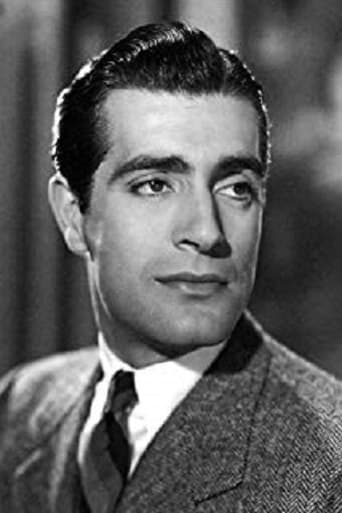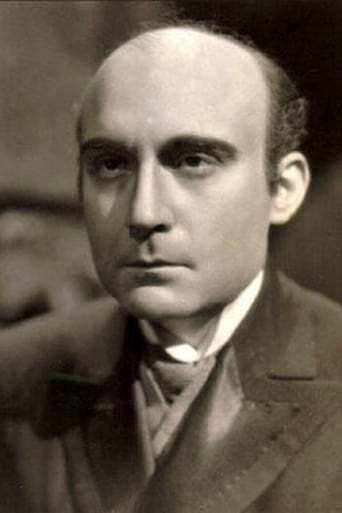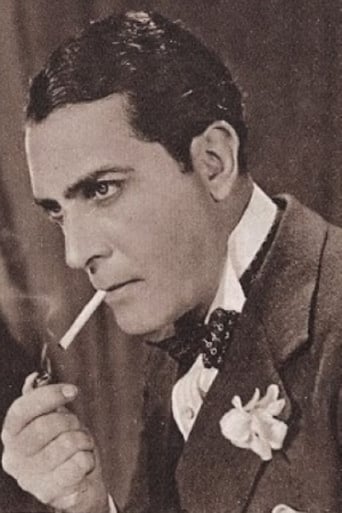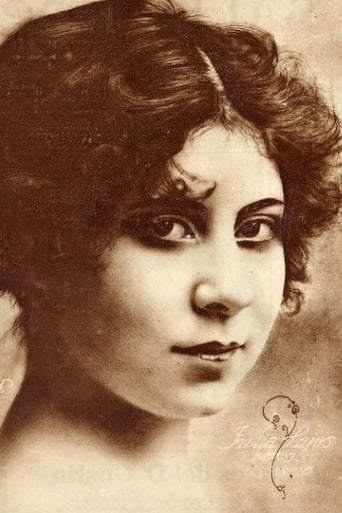Konterr
Brilliant and touching
Paynbob
It’s fine. It's literally the definition of a fine movie. You’ve seen it before, you know every beat and outcome before the characters even do. Only question is how much escapism you’re looking for.
Freeman
This film is so real. It treats its characters with so much care and sensitivity.
Gary
The movie's not perfect, but it sticks the landing of its message. It was engaging - thrilling at times - and I personally thought it was a great time.
Rueiro
This one is probably the oddest film ever made in Spanish cinema until the take-off of its fantastic and horror genre in the late 1960s. For that reason alone it is remarkable that it was made at all at an era as conservative and narrow-minded as the 1940s was, when Spain was isolated within Europe by the diplomatic and economic boycott of the Allies for having secretly helped the Axis during World War II. In those days of heavy fascist censorship, the films made in Spain where either bourgeois gentle comedies to give audiences a false feeling of optimism and prosperity in a country that was totally ruined, historical epics to remind us how great we once were, or religious dramas to glorify Spain's ultra-Catholicism against the threat of Communism and the Masons. During the early 1930s director Edgar Neville worked in Hollywood, adapting films for the Spanish-speaking market, and there he learnt a great deal about filmmaking. So when he took the reins of "The Tower" and wrote the script, he included slices of music-hall, screwball comedy, fairy-tale fantasy and German Expressionism, all combined together while keeping a very Spanish background of traditional Madrid cafés at the turn of the century, popular music and songs and people speaking in the local accent, with some location shots in the old quarter of the city that hadn't changed at all since the XIX century. As the movie starts we meet Basilio (Antonio Casal) an innocent and bit of a foolish guy. One evening he goes to try his luck at the casino but loses his modest gamble, but then he is approached by the ghost of an elderly gentleman who tells him which number to bet upon. Basilio reluctantly does so, and then wins then some cash which allows him to take his cabaret girlfriend out to supper to impress her but can't avoid being chaperoned by her big mother. Later that night he is visited by the ghost again, who then tells him that he was murdered by a secret society as he was about to discover some sinister plot of theirs, and now his niece is in danger from his murderers. Basilio eventually learns that the gentleman was an archaeologist, and that his associate vanished without a trace when the professor was killed. Basilio immediately falls in love with the niece and starts courting her, and at the same time we start seeing hunchbacks everywhere he goes to, and it becomes quite obvious that they are watching him. A second story within the story then begins to unravel, and it doesn't take us much thinking to deduce that the hunchbacks and the murder of the professor are connected and Basilio is now in the middle of it. One night he follows a hunchback to an old deserted house and ends up discovering a secret passage that leads to an underground city built by the Jews at the time they were being persecuted by the Inquisition, and there he bumps into the professor's long-time missing associate, who is now a bit gaga after being held captive for so long. We soon discover that the gang, led by a mysterious doctor we met a while back, has been engaged for years on digging and smuggling art objects out of the Jewish city and running a counterfeit money press at the same time. The doctor has now kidnapped the professor's niece and is holding her under hypnosis in the city as well, but at the end Basilio rescues her and both flee the city as it collapses after the doctor has exploded a device once he realised the game was over. At the end, with the dastardly villain and his evil organisation destroyed and the mystery of the professor's murder solved, Basilio and the girl will remain together and live happy ever after. The unusual and innovative combination of different genres makes it not only an interesting film in terms of content but also very entertaining, suspenseful and funny. It is also a beautiful and loving homage to German Expressionism: Dr Mabuse, Nosferatu, The Golem and The Student of Prague. And also it is blessed with a wonderful cast, led by the naturally gifted for comedy Galician-born actor Antonio Casal, accompanied by two of Neville's regulars: the charming and suave Guillermo Marin as the villain, and the delightful and always bigger- than-life and fantastic scene stealer Julia Lajos as the mother-in-law to fear. "The Tower of the Seven Hunchbacks" has become a cult classic, recently restored and now available in DVD. And it certainly is one of the best films made by one of the most original, creative, innovative and independent directors in Spanish cinema ever: Edgar Neville.
MARIO GAUCI
I first heard of this obscure but intriguing little item on the "Time Out" Film Guide and obviously leapt at the chance to acquire it recently from a French source – even if, alas, the print turned out to sport no English subtitles; I usually don't mind it so much – in the case, for instance, of Jess Franco movies – but I really felt like I was missing something here! From what I could gather (the Spanish language is partly similar to the Italian in which I'm fluent, but the worn soundtrack present here didn't make it any easier for me!) is fairly rich in twists with a one-eyed ghost (who, Cocteau-like, uses a mirror as a portal from the netherworld) bidding our hero to seek a secret society of hunchbacks involved in the trafficking of archaeological artifacts (but, from reading what few reviews I could find about the film, the latter's also asked to protect the old man's daughter and help her expose his own murderer). While I'm at it, let me just catalogue what other plot/visual elements seem to have escaped me (or else have already receded into my subconscious – given that I was watching it somewhat half-heartedly): the city of Hunchbacks was apparently built by victimized Jews during the Spanish Inquisition; there's talk of "thrilling horrors", "cobwebbed mummies" and "hypnotism", plus the fact that the villain (who, admittedly, is quite effective) is allowed to get away with it.Even so, these reviews are equally contradictory: one calls it "anything but conventional" whereas another states "while the movie has a wonderfully expressionist look and the story is certainly inventive, the plot unfolds in a very conventional way, and while entertaining, it isn't exactly the masterpiece that could have been or that its very artistic look may indicate" – for what it's worth, I tend to favor this latter view! Incidentally, while it would seem to evoke the feel of the contemporaneous Universal horror films, THE TOWER OF THE SEVEN HUNCHBACKS is really an obvious precursor to the loopier Mexican variety of genre outings which came into full swing during the subsequent decade. Like these other film buffs, however, I regretted the picture's comic relief (apparently, the source novel is more somber) – at one point, for no apparent reason, even Napoleon's ghost puts in an appearance! – and even more so the musical sequences.What eventually made the film worthwhile, then, were the atmospheric sets (even if, at this juncture, I wouldn't quite use the epithet "must be seen to be believed" to describe them!) and monochrome lighting. Needless to say, I'm grateful for the opportunity to sample this 'lost classic' but I'd love to revisit it in an improved edition – though, alas, I'm not holding my breath!
José Luis Rivera Mendoza (jluis1984)
Despite being the birthplace of the brilliant pioneer of fantasy films, Segundo De Chomón (whose films rivaled Georges Méliès in quality and inventive), Spain's filmography within the realm of the horror genre is considerably poor before the 60s, when Jesus (or Jess) Franco inaugurated Spaniard horror. This was the result of the difficult political climate of the country during the regime of dictator Francisco Franco. In fact, while there were a couple of fantasy films done before 1962, the only true horror film was a little known movie titled "La Torre De Los Siete Jorobados", directed by Edgar Neville, and based on a popular pulp novel written by Emilio Carrere. However, despite being the only example of Spaniard horror film-making in the 40s, this film is more than a mere curiosity, it is actually a forgotten gem of the genre.Set in 19th century Madrid, a young man named Basilio (Antonio Casal) decides to play roulette, hoping to make some money to go on a date with the girl he likes. Suddenly, a mysterious character appears (Félix De Pomés) out of nowhere, and tells Basilio exactly where the ball is going to fall. Winning a small fortune thanks to the stranger, Basilio decides to thank him for the help, only to discover that the mysterious man, named Don Robinson De Mantua, is the ghost of an archaeologist who supposedly committed suicided years ago. In return for the help at the roulette, Don Robinson asks Basilio to protect his daughter Inés (Isabel De Pomés) and help her solve his crime, as Don Robinson was actually murdered. And so Basilio gets involved in a mystery that will take him to discover the entrance to the Tower of the Seven Hunchbacks.As written above, "La Torre De Los Siete Jorobados" is based on Emilio Carrere's novel of the same name (which was partially written by Jesús De Aragón), however, there are many differences between the novel and the film, specially in the tone that scriptwriters Edgar Neville and José Santugini give to the story. While the novel has a somber dark humor, Neville's film ops for a lighthearted style, more in tone with American horror and adventure movies (that definitely were a big influence on Neville) than with its literary source. This is not really a bad thing, as the movie keeps the thrilling mix of mystery, humor and suspense of the novel, and I'd go as far as to say that Neville's decision of making a fun movie over a meaningful one actually benefits the film, as while certainly an imitation of Hollywood's typical style, it's anything but conventional.Where the movie excels is in its execution, as Neville gives good use to the excellent work of cinematography done by Henri Barreyre and Andrés Pérez Cubero, giving the film a haunting beauty. The most striking feature of the film is definitely its wonderful set design, with the recreation of the Tower of the Seven Hunchbacks having a beautiful expressionist look that feels like taken out from a 1920s German film. The contrast between the surreal expressionism of the Tower with the Gothic atmosphere of Madrid's streets (in scenes shot on location) give the movie an effective nightmarish look, which definitely bring back memories from the American horror films from the 30s (specially the ones by Universal Studios). However, what makes this mix of influences work is Neville's own brand of humor, which gives the film a distinctive personality of its own.The cast is for the most part effective, with Antonio Casal leading the cast and making a good job at handling the comedic side of his character (his Braulio is goodhearted, but cowardly and specially naive). As his romantic interest, Inés, actress Isabel De Pomés is good, although nothing really special. Still, this could be blamed to the fact that her character isn't very well developed and it's a stereotypical damsel in distress. On the other hand, Guillermo Marín is extraordinary as the mysterious Doctor Sabatino, delivering a powerful performance that definitely ranks among the best in Spain's horror filmography. Marín captures perfectly the mix of charming amiability and perverse wickedness that makes Sabatino such an interesting character and he is easily the best in the cast. Finally, Félix De Pomés is quite funny as Don Robinson's ghost, despite his limited screen time.Now, while "La Torre De Los Siete Jorobados" is certainly an excellent and entertaining film, it sadly is far from being perfect, mainly because in his attempt for imitating the commercially successful American films, director Neville also brings those films' flaws, specifically, their reliance on clichés. While the movie has a wonderfully expressionist look and the story is certainly inventive, the plot unfolds in a very conventional way, and while entertaining, it isn't exactly the masterpiece that could had been or that its very artistic look may indicate. This dependence on common clichés and some cheap jokes do make a bit simplistic and predictable what otherwise could had been a quite haunting tale of horror. Fortunately, the damage is not really big, and "La Torre De Los Siete Jorobados" can still be enjoyed without problem.Of course, this last criticism is probably just nitpicking, as in the end, "La Torre De Los Siete Jorobados" fulfills its purpose without great difficulty: it provides good entertaining as Basilio uncovers the thrilling horrors of the Tower of the Seven Hunchbacks. While it would take several years after this film's release for horror to resurrect completely, "La Torre De Los Siete Jorobados" did open the doors for the fantastic in Spain's filmography. For this and several other reasons (like its expressionist look, which must be seen to be believed), this little known gem is more than a mere curiosity, it is truly Spain's first horror classic.8/10




